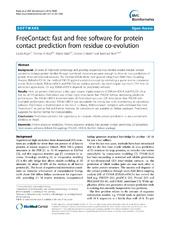| dc.contributor.author | Kaján, László | eng |
| dc.contributor.author | Hopf, Thomas A. | eng |
| dc.contributor.author | Kalaš, Matúš | eng |
| dc.contributor.author | Marks, Debora S. | eng |
| dc.contributor.author | Rost, Burkhard | eng |
| dc.date.accessioned | 2014-10-07T13:47:08Z | |
| dc.date.available | 2014-10-07T13:47:08Z | |
| dc.date.issued | 2014-03-26 | eng |
| dc.identifier.issn | 1471-2105 | en_US |
| dc.identifier.uri | https://hdl.handle.net/1956/8604 | |
| dc.description.abstract | Background: 20 years of improved technology and growing sequences now renders residue-residue contact constraints in large protein families through correlated mutations accurate enough to drive de novo predictions of protein three-dimensional structure. The method EVfold broke new ground using mean-field Direct Coupling Analysis (EVfold-mfDCA); the method PSICOV applied a related concept by estimating a sparse inverse covariance matrix. Both methods (EVfold-mfDCA and PSICOV) are publicly available, but both require too much CPU time for interactive applications. On top, EVfold-mfDCA depends on proprietary software. Results: Here, we present FreeContact, a fast, open source implementation of EVfold-mfDCA and PSICOV. On a test set of 140 proteins, FreeContact was almost eight times faster than PSICOV without decreasing prediction performance. The EVfold-mfDCA implementation of FreeContact was over 220 times faster than PSICOV with negligible performance decrease. EVfold-mfDCA was unavailable for testing due to its dependency on proprietary software. FreeContact is implemented as the free C++ library “libfreecontact”, complete with command line tool “freecontact”, as well as Perl and Python modules. All components are available as Debian packages. FreeContact supports the BioXSD format for interoperability. Conclusions: FreeContact provides the opportunity to compute reliable contact predictions in any environment (desktop or cloud). | en_US |
| dc.language.iso | eng | eng |
| dc.publisher | BioMed Central | en_US |
| dc.rights | Attribution CC BY | eng |
| dc.rights.uri | http://creativecommons.org/licenses/by/2.0 | eng |
| dc.subject | Protein structure prediction | eng |
| dc.subject | Protein sequence analysis | eng |
| dc.subject | Fast protein contact prediction | eng |
| dc.subject | 2D prediction | eng |
| dc.subject | Open-source software | eng |
| dc.subject | EVfold | eng |
| dc.subject | EVcouplings | eng |
| dc.subject | PSICOV | eng |
| dc.subject | mfDCA | eng |
| dc.subject | BioXSD | eng |
| dc.subject | Debian package | eng |
| dc.title | FreeContact: fast and free software for protein contact prediction from residue co-evolution | en_US |
| dc.type | Peer reviewed | |
| dc.type | Journal article | |
| dc.date.updated | 2014-04-22T03:32:26Z | |
| dc.description.version | Peer Reviewed | |
| dc.description.version | publishedVersion | en_US |
| dc.rights.holder | László Kaján et al.; licensee BioMed Central Ltd. | en_US |
| dc.rights.holder | Copyright 2014 Kaján et al.; licensee BioMed Central Ltd. | en_US |
| dc.source.articlenumber | 85 | |
| dc.identifier.doi | https://doi.org/10.1186/1471-2105-15-85 | |
| dc.identifier.cristin | 1153112 | |
| dc.source.journal | BMC Bioinformatics | |
| dc.source.40 | 15 | |





